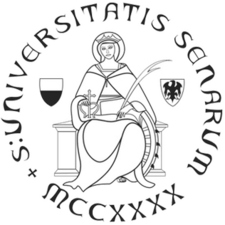University of Siena
| Università degli Studi di Siena | |
 |
|
| Latin: Universitas Senas | |
| Type | State-supported |
|---|---|
| Established | 1240 |
| Rector | Angelo Riccaboni |
| Students | 20,000 |
| Location |
Siena, Italy 43°19′9″N 11°19′57″E / 43.31917°N 11.33250°ECoordinates: 43°19′9″N 11°19′57″E / 43.31917°N 11.33250°E |
| Sports teams | CUS Siena |
| Affiliations | Coimbra Group, IRUN |
| Website | www.unisi.it/ |
The University of Siena (Italian: Università degli Studi di Siena, abbreviation: UNISI) in Siena, Tuscany is one of the oldest and first publicly funded universities in Italy. Originally called Studium Senese, the institution was founded in 1240. It had around 20,000 students in 2006, nearly half of Siena's total population of around 54,000. Today, the University of Siena is best known for its Schools of Law and Medicine.
On December 26, 1240, Ildebrandino Cacciaconti, the then podestà of Siena, signed a decree imposing a tax on citizens of Siena who rented rooms to students of the local "Studium Senese". The money from this tax went to pay for the salaries of the maestri (teachers) of this new studium. The studium was further supported when, in 1252, Pope Innocent IV declared both its teachers and students completely immune from taxes and forced labour levied on their person or property by the city of Siena. Moreover, the commune exempted teachers of law and Latin from military service and teachers of Latin were also excused from their duties as night watchmen. By the early 14th century, there were five teachers of Latin, logic and law and two doctors of natural sciences (medicine).
One of the most notable maestri of the School of Medicine was Pietro Ispano (Pope John XXI). Ispano was an illustrious philosopher, personal doctor to Emperor Frederick II, and in 1276 became Pope John XXI.
In 1321, the studium was able to attract a larger number or pupils due to a mass exodus from the prestigious neighbouring University of Bologna when one of its students was sentenced to death by Bologna's magistrates for supposedly kidnapping a young woman. Partly at the instigation of their law lecturer Guglielmo Tolomei, the student body there unleashed a great protest at the Bolognese authority and Siena, supported by generous funding from the local commune, was able to accommodate the students resigning from the Studium Bolognese.
The studium of Siena was eventually promoted to the status of "Studium Generale" by Charles IV, shortly after his coronation as Holy Roman Emperor in 1355. This both placed the teachers and students under the safeguard of the imperial authority (protecting them from the local magistracy) and also meant that the licences (licentiae docendi) granted by the university were licences ubique docendi. These licences entitled the person receiving them to teach throughout Christendom.
...
Wikipedia
